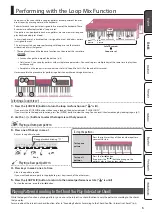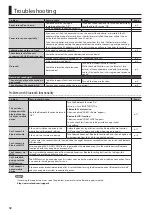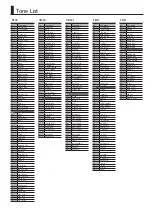
9
Setting Various Functions (Setting)
Indication
Value/Explanation
REVERB LEVEL *1
Adjusting the Reverberation (REVERB LEVEL)
This adds reverberation that is characteristic of a performance in a concert hall.
0–10
OCTAVE SHIFT *1
Changing the Pitch Range of the Keyboard in Steps of an Octave (OCTAVE SHIFT)
This shifts the pitch of the keyboard in steps of an octave.
-3–0–3
TRANSPOSE *1
Transposing the Pitch (TRANSPOSE)
The keyboard can be transposed in semitone steps.
For example if a song is in the key of E major but you want to play it using the
fingering of the C major scale, you would set the keyboard transpose setting to “4.”
-5–0–+6
MASTER TUNE
Matching the Pitch with Other Instruments (MASTER TUNE)
When playing ensemble with other instruments and in other such instances, you can match the standard pitch to another
instrument. The standard pitch generally refers to the pitch of the note that’s played when you finger the middle A key.
For a cleaner ensemble sound while performing with one or more other instruments, ensure that each instrument’s
standard pitch is in tune with that of the other instruments. This tuning of all the instruments to a standard pitch is called
“master tuning.”
415.3 Hz–440.0 Hz–466.2 Hz
KEY TOUCH
Specifying the Feel (Touch Response) of the Keyboard (KEY TOUCH)
This changes the feel (touch response) of the keyboard. If you’ve specified “Fix,” notes will sound at the same volume
regardless of how strongly you play the keyboard.
Fix, Light, Medium, Heavy
TOUCH SOUND
Emitting an Operation Sound When You Press a Button (TOUCH SOUND)
You can specify whether an operation sound is played (On) or is not played (Off) when you press one of this instrument’s
buttons.
SP PHONES SW
Muting the Speakers When Headphones Are Connected (SP PHONES SW)
This specifies whether connecting headphones automatically mutes this instrument’s speakers (On) or does not mute
them (Off).
GM2 TONE
Displaying GM2 Tones (GM2 TONE)
This specifies whether GM2 tones are shown (On) or not shown (Off) when you’re selecting tones.
Reference
For details on the GM2 tones, refer to “Tone List” at the end of this manual.
KEEP SETTING
Preserving the Settings When the Power Turns off (KEEP SETTING)
The following settings return to their default values when you turn off the power; however by turning this setting “On,”
you can preserve the settings that were in use when the power was turned off.
The next time the power turns on, those previous settings are reproduced.
Settings that can be preserved: PART VOLUME, TEMPO, REVERB LEVEL, OCTAVE SHIFT, TRANSPOSE, and the tone that is
selected for each group
SONG LOAD
Refer to “Loading a Song (SONG LOAD)” (p. 7).
SONG DEL
Refer to “Deleting a Song (SONG DEL)” (p. 7).
BLUETOOTH
Refer to “Using the Bluetooth® Functionality” (p. 10).
BT PAIRING
BLUETOOTH ID
BACKUP
Refer to “Backing-Up or Restoring Songs and Settings” (p. 7).
RESTORE
AUTO OFF
Making the Power Automatically Turn off After a Time (AUTO OFF)
This instrument automatically turns off its power when 30 minutes have elapsed since it was last played or operated (this
is the factory setting).
If you don’t want the power to turn off automatically, set Auto Off to “Off.”
Off, 30, 240 (min)
LCD CONTRAST
Adjusting the Brightness of the Display (LCD CONTRAST)
Adjusts the brightness of this instrument’s display.
0–10
FACTORY RST
Refer to “Restoring the Factory Settings (FACTORY RST)” (p. 8).
VERSION
This shows the version of this instrument’s program.
*1: Settings that can be preserved by KEEP SETTING
If you play C E G
0
It will sound E G B


















